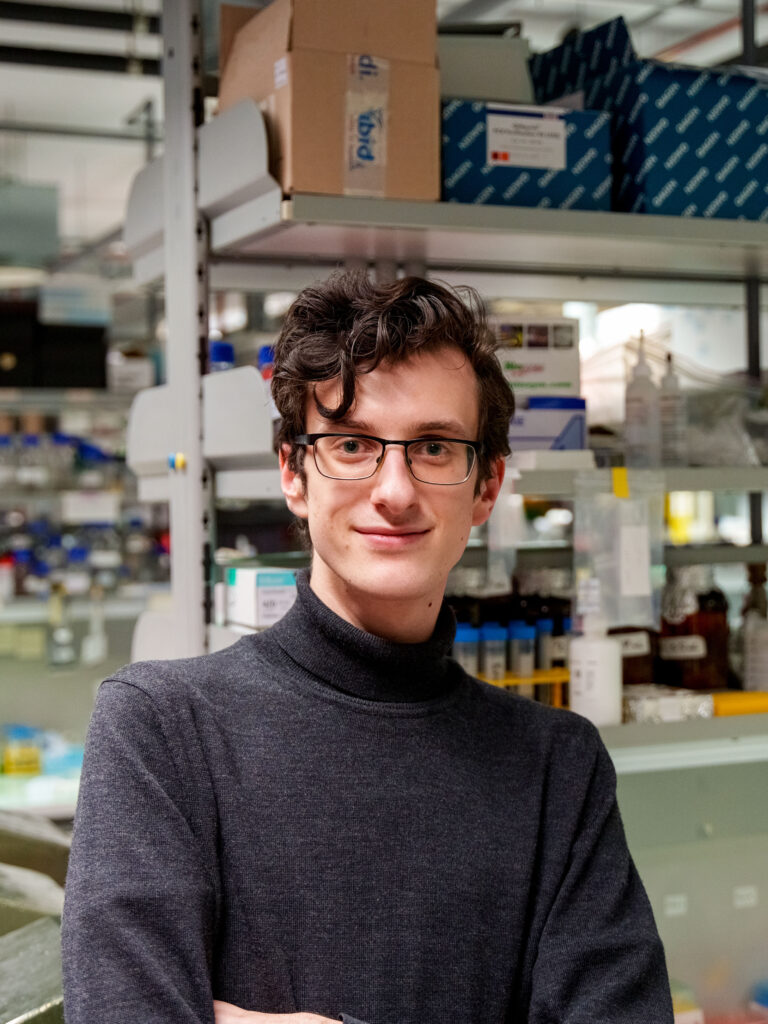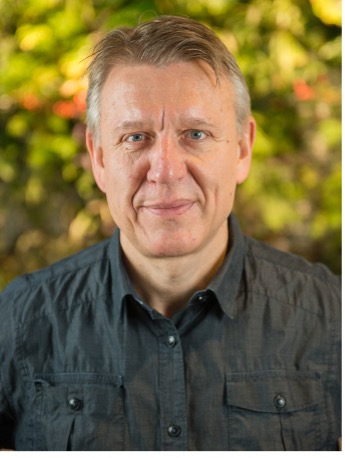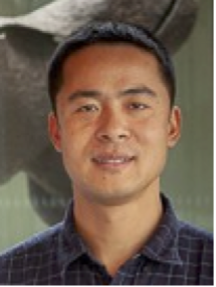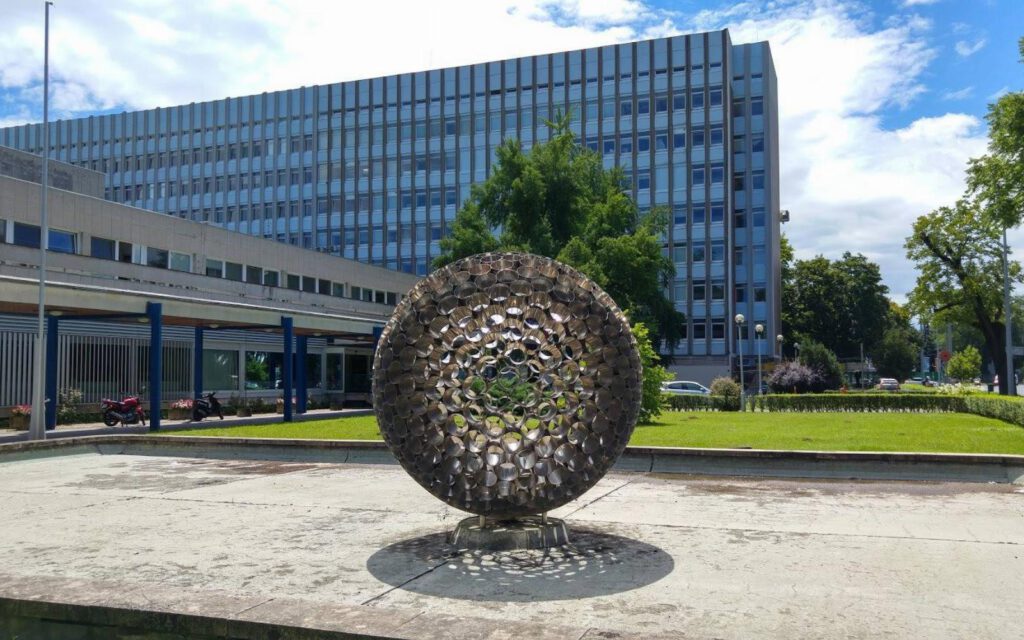Consortium
Universität zu Lübeck



Sebastian ‘Nino’ Karpf, coordinator of the SWEEPICS project, is Professor for translational biomedical photonics at the Institute of biomedical optics (BMO) at the University of Lübeck. He is the main inventor and driving force behind the SLIDE multiphoton technology and the pulsed swept source laser behind it, the FDML-MOPA laser. His research expertise spans laser development, fiber optics, electronics, microscopy, imaging, nonlinear optics, programming, data handling and biomedical applications.

Stefan Reinhards is a fourth-year PhD and research assistant at the University of Lübeck. He is a member of Prof. Dr. Sebastian Karpf’s group at the Institute for Biomedical Optics and works at the Medical Laser Center Lübeck. His research focuses on the development of new laser sources for kHz SLIDE microscopy. With his, he aims to enable real-time volumetric imaging of biological samples labeled with green fluorescent dyes and proteins, thereby expanding the SLIDE technology’s range of applications. Before his PhD, he studied medical engineering science at the same university and graduated with a master’s degree.

Tonio Kutscher is part of the project management team of Sweepics and a PhD student in the research group of Sebastian Karpf. He studied Medical Engineering and is currently working on frequency doubling of FDML MOPAs as well as the generation of optoacoustic signals with picosecond pulses in close cooperation with Tian Jin.
Optores GmbH


In his PhD thesis at the University of Munich, Wolfgang Wieser has worked on rapidly swept lasers and swept-source optical coherence tompgraphy (OCT). Together with Prof. Robert Huber, he and his colleagues pushed the sweep speed of Fourier Domain Mode Locked (FDML) tunable lasers into the multi-MHz range coining the terms “MHz-OCT” and “multi-MHz OCT”. This enabled, for the first time, high quality OCT imaging with billions of voxels per second and real-time volumetric imaging with live 3D display suitable for applications like surgical guidance. For his work, Wolfgang Wieser received the German Dissertation Award in 2017. Wolfgang Wieser is one of the founders and the current CEO of Optores GmbH, a spin-off from the University of Munich.
Apart from swept lasers and OCT, Wolfgang Wieser has a strong background in electronics and embedded software development. In the SWEEPICS project, he will primarily work on the electronics, including synchronization and laser pulse modulation.

Mr. Dipl. Phys. Tom Pfeiffer has been employed at Optores GmbH since 2019. Previously, he spent 8 years researching the development of FDML lasers and OCT systems at LMU Munich and the University of Lübeck under the supervision of Prof. Robert Huber. Mr. Pfeiffer has made significant contributions to the invention of novel control techniques for the FDML laser and has an in-depth understanding of the laser as well as OCT imaging. In the project, Mr. Pfeiffer will primarily be responsible for the optical, thermal, power, and mechanical design of the FDML-MOPA and testing.

Having finished his diploma thesis in experimental elementary particle physics at Ludwig-Maximilians-University in Munich, Alexander Mlynek spent the following 11 years of his academic career in nuclear fusion research. As a PhD student, PostDoc and finally researcher at the Max-Planck Institute for Plasma Physics, the focus of his work was on optical measurements on hot fusion plasmas based on interferometry and polarimetry, employing laser sources in the visible, far infrared and terahertz spectral range. Physical quantities of interest were the electron density of the plasma, as well as the internal magnetic field strength, which was measured by a polarimeter via the Faraday effect. In 2018, he joined Optores GmbH as an R&D engineer for fiber-optic ring lasers based on the Fourier-Domain Mode Locking (FDML) technology. Today, his key focus at Optores is the optimization of the optical, electro-optical, mechanical, electro-mechanical and electronic components required to make the world’s fastest swept sources for multi-MHz Optical Coherence Tomography (OCT) available to researchers all around the world.
MLL GmbH

More than 20 scientist and engineers with many years of experience work in the disciplines of optics, metrology, production engineering, realization of prototypes, regulatory issues and clinical studies.
More Information: https://mll-luebeck.com/en/home/


Dirk Theisen-Kunde, CTO at Medical Laser Center Lübeck (MLL) GmbH, studied Technical Physics at the Polytechnic University Lübeck (Germany) and Physics at the University of Loughborough (UK). After his Diploma-Thesis in “Experimental investigation of plasma formation in water with pico and nanosecond Nd: YAG laser pulses” he worked at the Institute of Biomedical Optics at the University of Lübeck in the field of endoscopic laser surgery. During this time he developed a surgical laser prototype in cooperation with the Bavarian laser company StarMedTec, ending up in a commercial product for surgical laser surgery called Vela Laser.Since 2010 he is CTO at the Medical Laser Center in Lübeck and is responsible for prototyping of medical and customized laser devices. A “Dental-OCT” Prototype was awarded by the “Dental Innovation Award 2018” in the category “Innovative Idea / Invention”. Together with the R&D team several ophthalmological prototypes were realized for the innovative approach called “Selective Retina Therapy (SRT)” that are used worldwide for scientific evaluation. Also an intra-operative MHz-OCT prototype for neuro-surgery is part of his actual work. Since 2022, the group is realizing prototypes for “spectro-temporal laser imaging by diffractive excitation” (SLIDE).

Maximilian Rixius studied Electrical Engineering at Aachen University of Technology. After years of work in industrial software engineering he now focuses on software for high-speed image acquisition, visualization, data storage and system control. He also designs and programs some custom analog and digital hardware modules used in the microscope systems built by MLL.
University of Zürich and ETH Zürich

University of Zurich (UZH) is the largest Swiss University and a member of the League of European Research Universities, the leading house of three National Centres of Competence in Research, and is a partner in numerous others. UZH has been home to 23 Nobel laureates and a Turing Award winner. The Preclinical Imaging Center (PIC) has a double affiliation with the Eidgenössische Technische Hochschule (ETH) Zurich, which is regularly ranked among the top-10 universities in the world. As of 2018, 32 Nobel laureates, 4 Fields Medalists and 2 Pritzker Prize winners have been affiliated with the ETH. The Center is home to scientists from diverse disciplines who work at the interface of engineering, physics, biology and medicine to devise new in vivo imaging tools that can tackle challenges unapproachable by existing modalities. PIC is also an integral part of the Institute for Biomedical Engineering and the Institute of Pharmacology and Toxicology.


Daniel Razansky is a Full Professor of Biomedical Imaging with double appointments at the Faculty of Medicine, University of Zurich and Department of Information Technologies and Electrical Engineering, ETH Zurich in Switzerland, where he also serves as Director of the joint Preclinical Imaging Center. He earned degrees in Biomedical and Electrical Engineering from the Technion – Israel Institute of Technology and conducted postdoctoral research at the Harvard Medical School. Previously, he was Professor of Molecular Imaging Engineering at the Technical University of Munich and Helmholtz Center Munich in Germany. The Razansky Lab pioneered a number of bio-imaging technologies that were successfully commercialized and put into use in research labs and clinical facilities across the globe, among them the multi-spectral optoacoustic tomography (MSOT) and hybrid optoacoustic ultrasound (OPUS). His research has been recognized by the German Innovation Prize and multiple awards from the ERC, NIH, SNF, DFG and HFSP. He is an elected Fellow of the IEEE, SPIE and Optica Societies.

Tian Jin is a researcher in biomedical imaging at ETH Zurich with experience in developing microscopic imaging systems. His main research focuses on developing optoacoustic and two-photon microscopes and applying them to address biological questions.
Medizinische Universität Wien

The Penninger lab made a key breakthrough by developing blood vessel organoids (BVO) derived from human pluripotent stem cells to model vascular disease (PMID: 30651639). These organoids self-assemble into capillary networks containing endothelial and pericyte cells enveloped by a basement membrane. This system can be used to study human vascular pathologies permitting genetic and therapeutic perturbations of the fully human blood vessels. Moreover, we are establishing microfluidic devices to create in vitro flow in human blood vessel organoids, a critical component for drug screening and therapeutic interventions using human engineered tissues.


Josef Penninger has extensive experience in basic research (e.g. Google H-index 179), leading large multinational research efforts (e.g. Haplobank which needed integration of many technologies and institutions (Elling et al. Nature 2017)), and developing, as founding director, one of the premier research institutes in Europe, IMBA. He is an expert in disease modelling such as cancer and angiogenesis and also engineering new tools (Stadlmann et al. Nature 2017; Wimmer, et al. Nature 2019) including the first human blood vessel organoids, which we will use within the Sweepics project.

Astrid Hagelkruys studied Molecular Biology at University of Vienna and did her PhD on epigenetic mechanisms at the Medical University Vienna. Her research focuses on epigenetics, neurobiology, immunology, mouse models and recently human blood vessel organoids. Since 2018 she is Senior Research Associate and supervising research projects, mentoring PhD students and managing the Vienna branch of the Penninger laboratory at IMBA and the Medical University of Vienna.

Kirill Salewskij is a fourth year PhD student in Dr. Josef Penninger’s group at the Medical University of Vienna. Previously, he worked at the Max Planck Institute of Molecular Biomedicine in the field of mouse embryonic self-organization. For his PhD, Kirill transitioned to the field of human stem cells and vascular biology. Currently, his projects focus on modelling a plethora of vascular and hematopoietic disorders in vitro through the use of vascular organoids to explore opportunities for genetic and pharmacological intervention. Kirill has successfully completed his PHD and left the laboratory of the MUW to take on new challenges . His work is continued by Emanuel.

Emanuel Tenorio is a dedicated Stem Cell Biologist. He completed his undergraduate studies at University of Milan and later on successfully earned his Master’s Degree in Molecular Biology from University of Vienna, acquiring experience in blood vessel and bone marrow organoids generation. Currently, he has joined Josef Penninger’s Lab to pursue his PhD, focusing on the development of vascular hematopoietic organoids as a model for blood-related malignancies and their possible application for pharmacological screenings.
Angios


Teodor Yordanov studied biology at the Leopold Franzens University of Innsbruck before joining the group of Prof. Lukas A. Huber at the Medical University of Innsbruck, where he completed his PhD thesis in the field of molecular cell biology and oncology. He them moved to the University of Queensland in Brisbane, Australia, working as a Postdoctoral fellow on rare vascular diseases, developing 3D vasculature models. As a Head of R&D at Angios his focus is to oversee the progress and provide scientific support for ongoing and future projects.

Iris Krainer-Eller is a biologist, specializing in Organoid Technology. During her studies at the Medical University of Innsbruck in molecular cell biology and oncology she completed an Internship at the Hubrecht Institute in The Netherlands where she was trained in Organoid Technologies at the Lab of Prof. Dr. Hans Clevers. She established human and mouse intestinal and human liver organoids at the Medical University of Innsbruck to study rare childhood diseases and developed a platform for Precision Cancer Medicine at the ADSI (Austrian Drug Screening Institute of Innsbruck) by generating patient derived colorectal cancer organoids. At Angios she is now working as a Scientist doing research on blood vessel organoids.
The scientists from Angios are responsible for the generation of BVOs for their use within the SWEEPPICS consortium. Through this collaboration we aim at gaining a better understanding of BVO physiology utilizing high content imaging, allowing us to optimize our production protocols.
Karolinska Institutet



Prof. Staffan Strömblad is the group leader of the clinical molecular biology lab at Karolinska Institutet (KI). Strömblad is expert in cancer biology and cell-matrix interactions- and his group regularly uses quantitative microscopy. He serves as the Director of the Live Cell Imaging (LCI) core facility at KI, as well as the Breast Cancer Theme Center at KI. Strömblad is a Member of the Nobel Assembly at KI.

Dr. Sylvie Le Guyader is the manager of the Live Cell Imaging core facility (Nikon Center of Excellence) at Karolinska Institutet. She is expert in various state-of-the-art microscopes. Le Guyader is also the director of the LCI microscopy course “Microscopy: Improve Your Imaging Skills – From Sample Preparation to Image Analysis” to PhD students and Postdocs at KI and across the world.

Dr. Jianjiang Hu is a quantitative and systems biomedicine researcher at Karolinska Institutet. He has more than fifteen years interdisciplinary research experience in quantitative and systems microscopy.
Partner Ali Mirazimi @ KI


HUN-REN Biological Research Centre (BRC)


Peter Horvath is currently the director and a group leader in the Biological Research Center in Szeged and holds a Finland Distinguished Professor Fellow position in the Institute for Molecular Medicine Finland, Helsinki. Starting from October 2023 he is a Senior Researcher of the AI4Health Institute at the Helmholtz Center, Munich. He obtained his Master’s diploma as a Computer Scientist at the University of Szeged, Hungary. In 2008, he finished his PhD at the University of Nice, Sophia Antipolis, France. Since then, he has pioneered the analysis and single cell-based phenotyping of high-content screens for which he developed outstanding image correction, segmentation, and phenotyping methods. Besides, he has participated in data analysis of several of the first dozen whole human genome-wide siRNA screens. He has developed image-based analysis technologies to discover novel drug treatments for cancer patients. Also, he has elaborated the algorithms that have led to the discovery of the role of the HDAC6 gene in and potential drug targets for influenza infection and has developed methods that precisely localize the role of drugs and genes involved in influenza infection. He is the co-founder of the European Cell-based Assays Interest Group (www.eucai.org) and served as a counsellor for the Society of Biomolecular Imaging and Informatics (www.sbi2.org). His groups generally focus on finding computational solutions to biological problems, combining wet-lab and light microscopy with image analysis and machine learning. His scientific results have been published in high-impact journals such as Science, Cell, Nature Reviews Drug Discovery, Nature Methods, PNAS, eLife, EMBO Journal, Pattern Recognition.

Akos Diosdi, MSc, studied Cell and Molecular Biology at the University of Szeged (Hungary). After obtaining his Bachelor of Science, he joined the Biological Image Analysis and Machine Learning Group (BIOMAG), Synthetic and Systems Biology Unit, Biological Research Centre (BRC, Szeged, Hungary) where he pursued a Master degree in BioInformatics. For his exceptional work in 2019, he was given the Discipuli pro Universitate Award. Since then, he started his PhD studies under the supervision of Prof. Peter Horvath and he received the Straub Young Researcher Award for his scientific achievements. His main research fields are: “Light-sheet Microscopy”, “In Vitro 3D Models”, “Imaging Technology”, “Clearing Protocols”, and “Computational Biology”. He has eight articles published in prestigious scientific journals and has made numerous contributions to outstanding international conferences.
